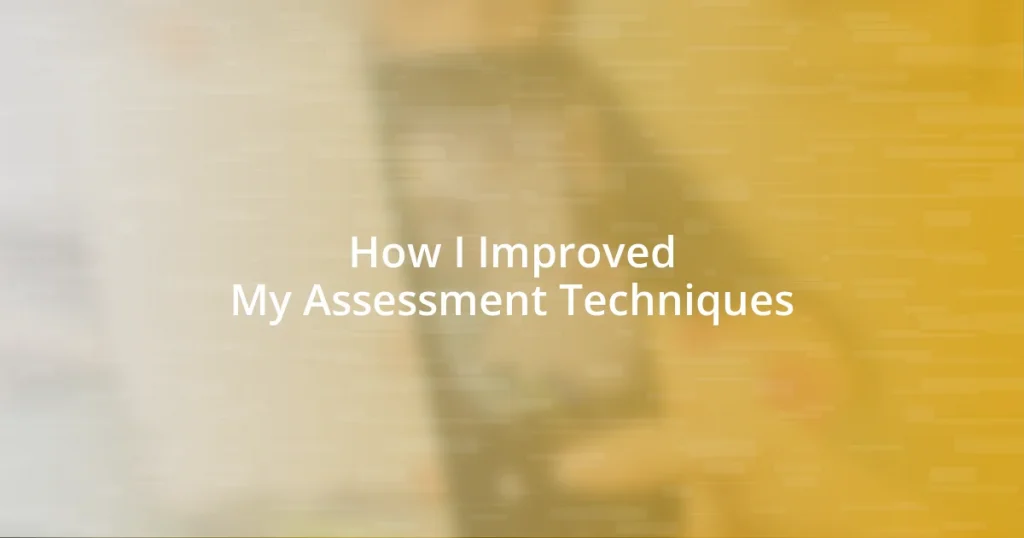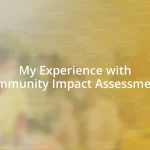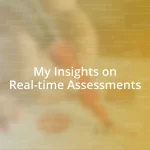Key takeaways:
- Transitioning from traditional assessments to formative and peer assessments significantly increased student engagement and understanding through collaborative learning.
- Utilizing diagnostic assessments and providing timely feedback helped tailor teaching to individual student needs, enhancing overall learning outcomes.
- Incorporating technology and continuously seeking student feedback allowed for innovative assessment methods, fostering a more dynamic and inclusive learning environment.

Understanding Assessment Techniques
Understanding assessment techniques goes beyond merely grading student work; it’s about comprehending how these methods impact learning. I remember the first time I used formative assessments in my classroom. The shift from traditional testing to ongoing assessments allowed me to see not just where my students struggled, but also how they thrived. It felt like uncovering hidden treasures of knowledge, as I understood their learning paths more intimately.
We often think of assessments as end-of-term exams, but they can be powerful tools for growth throughout the learning process. When I incorporated peer assessments, I was amazed at the level of engagement it sparked among the students. They didn’t just return work to me; they had discussions about their insights, which allowed them to learn from each other in ways I couldn’t facilitate alone. Have you ever witnessed a moment when students grasp a concept more clearly while helping one another? That’s the beauty of collaborative assessment!
It’s essential to explore various assessment types—formative, summative, diagnostic, and so on—because each serves a unique purpose. I found that diagnostic assessments, in particular, provided invaluable insights about initial student understanding. Reflecting on my approach, I now realize that these techniques equip educators like me to tailor our teaching to meet the needs of our students effectively. How can you leverage these assessment techniques to support your learners better?

Identifying Weaknesses in Assessments
Identifying weaknesses in assessments is a critical step in refining my approach. I remember the discomfort of realizing that some of my tests were measuring memorization rather than understanding. It felt frustrating to discover that students were struggling with concepts simply because the assessments didn’t align with the learning objectives. A thorough review of assessment results prompted me to pinpoint recurring patterns where students fell short.
To dive deeper into areas where my assessments were lacking, I created a checklist for reflection:
- Alignment with Objectives: Are assessments directly measuring the intended learning outcomes?
- Variety of Question Types: Do I include different formats (e.g., multiple-choice, essays) to cater to diverse learning styles?
- Clarity of Instructions: Are students able to easily understand what is being asked of them?
- Feedback Mechanism: Am I providing timely and constructive feedback that encourages improvement?
- Real-World Application: Do assessments relate to real-life scenarios that enhance relevance and engagement?
These steps have not only helped me address weaknesses but have also illuminated pathways to foster a richer learning environment.

Researching Evidence-Based Strategies
Researching evidence-based strategies has been a revelation on my journey to improve assessment techniques. Initially, I relied on intuition when selecting methods, but it quickly became clear that research-based practices could enhance my effectiveness. I vividly recall stumbling upon a study that highlighted the benefits of timely feedback and how it can dramatically improve student performance. Implementing this insight into my routine created a significant shift in how engaged my students became. Have you ever tried something new that transformed the way you approached a familiar task?
Diving deeper into this research, I found frameworks that laid out exactly how to implement these strategies in my assessments. For instance, discovering the importance of formative assessments truly reshaped my understanding. I remember feeling a sense of purpose as I began to apply ongoing assessments rather than waiting until the end of a unit. It was like having a compass guiding me toward immediate insights about my students’ learning journeys. Through this process, I realized that fostering a growth mindset in my classroom was not just beneficial but necessary.
The comparisons I drew from various evidence-based strategies helped me to choose what resonated best with my teaching style. I created a chart to visualize the differences and impacts of each method, which added clarity to my decision-making process. Having a visual representation of strategies reinforced my understanding and allowed me to modify my approach based on what truly worked.
| Strategy | Impact |
|---|---|
| Formative Assessment | Encourages ongoing feedback; promotes learning adjustments. |
| Peer Assessment | Boosts engagement; encourages collaboration and deeper understanding. |
| Diagnostic Assessment | Identifies initial understanding; informs tailored instruction. |

Implementing New Assessment Methods
Implementing new assessment methods was a transformative experience for me. I remember the first time I tried project-based assessment. I felt a mix of excitement and anxiety, wondering how my students would respond to this hands-on approach. Surprisingly, their engagement skyrocketed. It was incredible to see them invest in their projects, demonstrating skills I hadn’t fully recognized in traditional tests. Have you ever felt that moment when students truly take ownership of their learning? It’s exhilarating.
Incorporating technology into assessments was another game changer. I decided to use digital platforms for quizzes and interactive polls, and it not only made grading more efficient but also provided instant feedback for both me and my students. The first time I experienced the ease of running a live quiz where students could respond in real time was eye-opening. I felt a true connection—seeing their immediate reactions helped me adjust my teaching strategies on the fly. It left me wondering how I ever managed without these tools.
Reflecting on these changes, I realized that openness to experimentation has been the key. Trying out peer assessments was particularly enlightening. At first, I hesitated to let students critique each other’s work, fearing potential backlash or confusion. But when I finally took the plunge, I was amazed by the depth of insight my students had to offer each other. It made me think: why didn’t I embrace this sooner? Seeing them articulate feedback stirred a newfound respect for their voices in the classroom, and it truly enriched our learning experience.

Gathering Feedback from Peers
Gathering feedback from peers has been a game changer for my teaching practice. I distinctly remember the first peer review session I set up. My students were initially apprehensive, unsure about sharing their thoughts on each other’s work. But once they got started, it was fascinating to see how engaged they became, providing constructive feedback that was often more insightful than I anticipated. I realized, in that moment, how much they valued their peers’ perspectives.
The emotional shift in the room during these sessions was palpable. I found myself experiencing a blend of pride and relief as students animatedly discussed their critiques. Watching them support one another through their feedback felt like rediscovering a team spirit I didn’t know was possible in a traditional classroom setting. It made me reflect: how often do we underestimate our students’ capabilities to help each other grow? This collaborative approach not only enhanced their learning but also built a community of trust within the classroom.
After a few rounds of peer feedback, I noticed a remarkable increase in the quality of work my students were producing. They began to take ownership of their learning journey, driven by the accountability they felt towards their classmates. The process taught me that fostering an environment for peer assessment was not just about improving grades; it was about cultivating interpersonal skills and deepening their understanding. Isn’t it rewarding when a simple shift in strategy yields such profound results? I gained a newfound appreciation for the power of collective learning and how it can profoundly impact assessment techniques.

Analyzing Assessment Outcomes
Analyzing assessment outcomes has been a real eye-opener for me. One day, as I sifted through the results of a recent project, I stumbled upon a startling trend: some students excelled while others struggled despite similar effort. It struck me — how could I bridge this gap? This prompted me to dig deeper into their work, grouping assessments by understanding levels instead of traditional grades. I found that individualized feedback played a crucial role in helping me pinpoint where each student needed support.
When reflecting on these outcomes, I began to see patterns that I hadn’t noticed before. I remember noticing how engagement during lessons directly correlated with performance in assessments, an insight that prompted me to adapt my teaching methods. Have you ever questioned why some activities resonate better with your students? For me, this meant not only embracing diverse teaching styles but also experimenting with how I communicated learning objectives. By making them clearer, I saw improvements in both student understanding and assessment outcomes.
Moreover, what stood out during this analysis was the emotional component tied to results. I recall a moment when a typically quiet student expressed sheer joy over her progress. She had struggled last semester, but through targeted feedback and open dialogues, she not only improved her grades but also her confidence. This experience drove home the importance of not just looking at numbers; it’s about understanding the stories behind those numbers. Isn’t it fascinating how these insights can shape our teaching and ultimately enhance our students’ learning journeys?

Continuous Improvement of Techniques
Continuous improvement in assessment techniques is something I’ve embraced wholeheartedly. I vividly recall an instance where I modified my assessment format after noticing students struggled to demonstrate their knowledge through traditional tests. Shifting to project-based assessments not only sparked creativity but also allowed them to showcase their understanding in a way that felt authentic. Doesn’t it resonate with you when students can express their mastery in a format that suits them?
As I continued refining my techniques, I began incorporating technology into assessments. Tools like interactive quizzes and digital portfolios encouraged students to engage with the material more dynamically. I’ll never forget the day one student, typically shy and withdrawn, shared his digital project with the class. The sense of pride in his voice was unmistakable. Have you witnessed that moment when a student truly shines? It was an eye-opener for me, realizing that adapting my approach made learning more engaging for everyone.
Emotional feedback became an integral part of my continuous improvement journey, too. I asked students for their thoughts on new assessment methods. Their responses opened my eyes to how they perceived the changes. Some felt nervous about new formats, while others relished the chance to innovate. By embracing their feelings and input, I adapted my techniques further and fostered a classroom where every voice counted. It’s incredible to see how paying attention to emotions in the learning process can lead to breakthroughs, don’t you agree?















